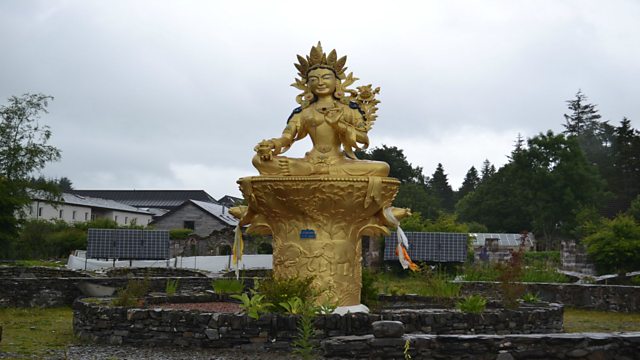
06/08/2015
Pennie Latin visits the Kagyu Samye Ling centre near Eskdalemuir to discover how growing and meditation go together. Plus she hears about the Scottish tea that loves the rain.
The Kagyu Samye Ling centre near Eskdalemuir was the first Buddhist monastery and Tibetan centre built in the West. It was set up in 1967 and remains the biggest in Europe to this date. Pennie Latin visits the volunteer run gardens and meets head gardener Tony Freck and one of his helpers Scott to hear what has inspired them and kept them here. Nun Ani Lhamo describes life at the centre while showing Pennie the golden Buddhas and visiting the beautifully decorated temple.
The kitchen garden here supplements the kitchens which can feed up to 150 people each meal time. But with the recent weather Chef Josep explains there isn't much to harvest and eat.
However, some plants love all this damp weather, especially tea. Pennie Latin and Kerry Duff travel to Galloway's first tea plantation to meet Angela Hurrell who began growing it in 2014.
Last on
Clip
-
![]()
The Kitchen Garden Trailer - Kagyu Samye Ling
Duration: 00:38
Kitchen Garden Plot Blog - The diary of a 鈥榞row your own鈥� enthusiast.

Now that I have finally got on top of my weeds, I am left in a state of uncertainty! I have busily pulled up all the offending plants, only to find that many of them are actually good from a medicinal point of view鈥�. Since my visit with the Kitchen Garden crew to Poyntzfield Herb Nursery on the Black Isle, I have increased my medicinal herb book collection to three and have been reading some very interesting things. For example, daisies are said to be good for bruises and fresh wounds, cuts etc. and chewing the leaves is good for mouth ulcers. Nettles are also said to have medicinal properties 鈥� apparently good for asthma and weight loss, but is generally considered to be a good tonic, giving the body a bit of a pick me up in the spring.聽
Even the beautiful but very invasive Celandine can be used for curing piles 鈥� I am glad I have no need to try it!!聽
The good thing about most of these 鈥榳eeds鈥� is that they are abundant (especially on some other allotment plots 鈥� I am going to receive some cold shoulders for that remark) so have a plentiful supply. However, should my plot become overrun again, I can always say that the weeds are deliberate and there for my new hobby of medicinal herbalism. 聽So, I am well into my planning with regard to these herbs, and have found supplies of small bottle for tinctures, infusions and so on. It will be fun to explore this in depth in the coming months.
My potatoes are still blight free, but I cannot say the same for my other related crop, tomatoes. How blight got into them I cannot properly figure out, but it must have been from the odd occasion that I have left the door open to allow circulation on a hot day.聽
The good news is that it is normally easily controlled in the greenhouse. Outside, the spores are easily spread in windy conditions, or birds brushing up along plants, but inside the conditions are normally very still and therefore, if you are quick, but careful, to remove offending leaves and tomatoes (they start to get blotchy brown, possibly cracking as well) you should get on top of the situation, and please do it before watering鈥�. Please make sure to use gloves that are kept separate to other gloves and are only used for this purpose. If you use bare hands, you will need to wash them straight after, but be careful about contaminating supplies used for watering your garden.聽
The picture shows how the blight looks on the tomato leaf, hopefully, you will notice the silver halo around the brown infection.
Broadcast
- Thu 6 Aug 2015 13:30麻豆官网首页入口 Radio Scotland


